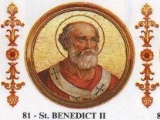
Pope Benedict II
Encyclopedia
Pope Saint Benedict II was Pope
from 684 to 685.
Pope Benedict II died on May 8, 685. He succeeded Leo II
. Although chosen in 683, he was not ordained until 684 because the leave of Emperor Constantine IV
was not obtained until some months after the election. According to Liber Diurnus Romanorum Pontificum
, he obtained from the Emperor a decree which either abolished imperial confirmations altogether or made them obtainable from the Exarch of Ravenna. This gave the power of confirmations of papal nominations directly to the Church and the people of Rome. Benedict symbolically adopted Constantine's two sons Justinian
and Heraclius.
To help to suppress Monothelitism
, he endeavoured to secure the subscriptions of the bishops of Hispania
to the decrees of the Third Council of Constantinople
, of 678, and to bring about the submission to the decrees of Macarius, the deposed bishop of Antioch.
Restorations of numerous churches in Rome are ascribed to the less than a year's pontificate of Benedict II.
Pope
The Pope is the Bishop of Rome, a position that makes him the leader of the worldwide Catholic Church . In the Catholic Church, the Pope is regarded as the successor of Saint Peter, the Apostle...
from 684 to 685.
Pope Benedict II died on May 8, 685. He succeeded Leo II
Pope Leo II
-Background and early activity in the Church:He was a Sicilian by birth , and succeeded Agatho. Though elected pope a few days after the death of St. Agatho , he was not consecrated till after the lapse of a year and seven months...
. Although chosen in 683, he was not ordained until 684 because the leave of Emperor Constantine IV
Constantine IV
Constantine IV , , sometimes incorrectly called Pogonatos, "the Bearded", by confusion with his father; was Byzantine emperor from 668 to 685...
was not obtained until some months after the election. According to Liber Diurnus Romanorum Pontificum
Liber Diurnus Romanorum Pontificum
Liber Diurnus Romanorum Pontificum is the name given to a miscellaneous collection of ecclesiastical formulae used in the Papal chancery until about the 11th century...
, he obtained from the Emperor a decree which either abolished imperial confirmations altogether or made them obtainable from the Exarch of Ravenna. This gave the power of confirmations of papal nominations directly to the Church and the people of Rome. Benedict symbolically adopted Constantine's two sons Justinian
Justinian II
Justinian II , surnamed the Rhinotmetos or Rhinotmetus , was the last Byzantine Emperor of the Heraclian Dynasty, reigning from 685 to 695 and again from 705 to 711...
and Heraclius.
To help to suppress Monothelitism
Monothelitism
Monothelitism is a particular teaching about how the divine and human relate in the person of Jesus, known as a Christological doctrine, that formally emerged in Armenia and Syria in 629. Specifically, monothelitism teaches that Jesus Christ had two natures but only one will...
, he endeavoured to secure the subscriptions of the bishops of Hispania
Hispania
Another theory holds that the name derives from Ezpanna, the Basque word for "border" or "edge", thus meaning the farthest area or place. Isidore of Sevilla considered Hispania derived from Hispalis....
to the decrees of the Third Council of Constantinople
Third Council of Constantinople
The Third Council of Constantinople, counted as the Sixth Ecumenical Council by the Roman Catholic and Eastern Orthodox churches and other Christian groups, met in 680/681 and condemned monoenergism and monothelitism as heretical and defined Jesus Christ as having two energies and two wills...
, of 678, and to bring about the submission to the decrees of Macarius, the deposed bishop of Antioch.
Restorations of numerous churches in Rome are ascribed to the less than a year's pontificate of Benedict II.

